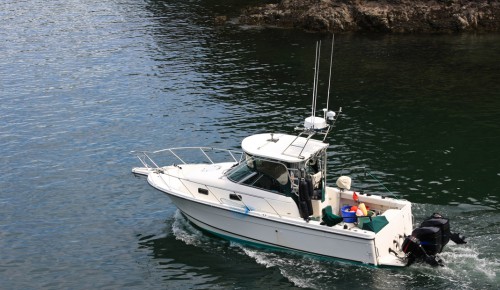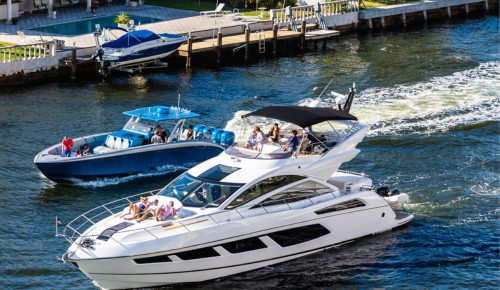What size boat do you need for family of 6?” The recommended watercraft size for a family of six is 30 to 40 feet, as far as the length of boat is concerned. You could push the vessel size to a minimum of 23 feet if you consider other factors.
Vessel living space requirements, amenities, watercraft activities, and safety features are crucial to the ideal boat sizes for your family. Moreover, the family’s budget (initial and ongoing) can determine the final watercraft size.
So, how about you continue reading to learn how big of a boat you need for your family or group of six? Let’s start.
Table of Contents
Recommended Boat Sizes for Families of 6
Prospective owners can use different methods to determine the ideal boat size for a family of six.
- They could use a brand-specific boat size chart, which often includes a description of passenger capacity.
- Alternatively, buyers can employ the US Coast Guard’s straightforward formula for determining the recommended boat size. The solution requires multiplying 15 by the number of people using the vessel. The result will be the area of the boat in square feet, or the length of boat multiplied by the average width of a boat.
Although USCG’s solution is straightforward, the result doesn’t account for storage spaces and other boat components.
Moreover, boaters must apply the principles of boat dimensions explained in simplest terms. Hence, you’re better off using a watercraft or yacht size chart.
1. Ideal size
Thirty to forty feet would be the ideal boat size for a family of six. You could opt for something bigger if family members require more privacy and you must go on extra-long voyages. For instance, a 40-foot vessel would be ideal for ocean travel.
- Minimum size
The minimum size boat you could get for a family of six is around 23 feet, although it can vary according to use and other factors.
For example, a 20-foot small boat size might be sufficient for several hours of fishing on lakes, ponds, reservoirs, and rivers once or twice monthly.
On the other hand, you’ll need a bigger boat to go offshore and fish. It’s not about the gear and catch requirements but the big waves you might encounter.
Families of six planning regular weekend fishing trips must opt for a minimum size of boats of 25 to 30 feet.
- Maximum size
Budget is the only factor that could prevent you from oversizing your boat for a family of six. Large vessels between 40 and 65 feet or longer aren’t your average boat size. Because these watercraft can accommodate more than six, they could be your second home.
We prepared the following boat size comparison to help you decide.
- Small to Mid-sized Boats
Small boat dimensions don’t exceed 26 feet, although medium-sized boats can reach 40 feet. These watercraft are ideal for inland water and coastal use, allowing families of six to enjoy fishing, recreational boating activities, cruising, and water sports.
Examples are dinghies, fishing boats, deck boats, pontoon boats, and cuddy cabin boats. These vessels vary in measurements. For instance, aluminum fishing boat dimensions range from 8 to 24 feet, while dinghies are 6 to 20 feet.
- Mid to Large-sized Boats
With the cutoff at 40 feet, mid-sized boats can extend to the realm of large vessels up to 65 feet long. Examples of these vessels are cabin cruisers, bowriders, sailboats, sport fishers, and yachts.
The dimensions of a boat in this category allow users to operate vessels in choppy waters without losing stability and endangering passenger safety.
- Large Boats
Ferries and yachts are examples of large watercraft that measure over 65 feet. These are rarely owned by regular boaters and would be too extravagant for most people.
You can analyze different size boats to determine the most appropriate watercraft for a family of six.
2. Usage
Boats for families of six also vary in size according to use.
- Fishing – Fishing boat sizes range from small to large, depending on the fishing grounds. For example, a 10-foot watercraft is sufficient for angling in rivers, lakes, reservoirs, and other inland waterways. You’ll need at least 25 feet for offshore fishing.
- Recreation – A 15-footer is enough for cruising during the day. However, you’ll need more space for sleep essentials and other gear when cruising overnight. A 20-foot vessel would be the smallest you must get.
- Water sports – The minimum boat size you must take for wakeboarding, wake surfing, tubing, and water skiing is 15 feet.
- Sailing – A 25-foot sailboat is a good boat to buy for a family of six as it provides basic amenities. You can opt for a larger vessel to make sailing more enjoyable.
Boat Size Classes
We summarized the boat size classification in the following tables.
1. Boat sizes based on USCG classification, location, and use
| Boat Size | USCG Boat Type | Where to Use | Suitable Activities | Examples |
| Less than 16 feet | Class A | Relatively calm waters (lakes, rivers, near shore) | Water sports, fishing, and recreation | Canoes, kayaks, PWCs (jet skis), inflatable boats, dinghies, small fishing boats |
| 16 feet to less than 26 feet | Class 1 | Inland waterways, open seas in calm waters | Fishing, water sports, recreation | Small deck boats, pontoon boats, aluminum fishing boats, surf boats. ski boats, jet boats, cuddy cabin boats, wakeboard boats |
| 26 feet to less than 40 feet | Class 2 | Open seas, coastal areas in calm waters | Cruising, fishing, recreation, pleasure boating | Cabin cruisers, runabout boats, trawler boats, bowriders, sailboats |
| 40 feet to less than 65 feet | Class 3 | Most bodies of water, including the high seas | Sailing, dockside dining, fishing, cruising, recreation | Cigarette boats, catamarans, trimarans, sport fishers, sailboats, yachts |
2. Recommended boat dimensions based on purpose
| Purpose | Minimum Boat Size | Recommended Boat Size |
| Recreational freshwater fishing | 10 feet | 15 to 20 feet |
| Recreational saltwater fishing | 25 feet | 30 to 40 feet |
| Day cruising and watersports | 15 feet | 20 to 30 feet |
| Overnight cruising | 20 feet | At least 25 feet |
| Offshore boating | 25 feet | At least 30 feet |
| Sailing | 25 feet | At least 30 feet |
Factors to Consider When Determining Boat Size
Although average boat length and other dimensions can help determine the ideal vessel size for a family of six, the following factors can further improve selection.
- Boating location – Choppy or rough waters (i.e., open seas and wide lakes) require larger vessels to ensure stability and safety.
- Storage – Fishing boats require more compartments for fishing gear and related accessories, including livewells. Meanwhile, an all around family boat will demand more storage space for personal effects, especially families on overnight cruising trips.
- Living space – A small boat is enough for a family of six if they don’t require sleeping quarters, a kitchen, a dining area, and other home-like amenities.
- Intended use – As a rule, fishing boats are larger than recreational and sporting vessels. These watercraft need space for passengers and fishing gear on top of the usual vessel components.
Additional Tips for Comfortable Family Boating
Families of six must find boating safe and comfortable, regardless of the type of boat for family they use. Here are some tips to ensure such a goal.
- Share your experiences about boating, focusing on safety at all times.
- Teach family members about boating safety rules, including wearing life jackets, using sound and visual signaling devices, and other items.
- Make the boating trip as fun as possible, especially if you have kids. Tailor-fit the activities to children’s ages.
- Consider hiring a crew member (i.e., a skipper) to help you spend more time with the family instead of focusing on piloting the vessel.
- Although planning your boat trip is essential, allow some leeway for variety and improvisation. Nobody likes to go on a boating trip with a very tight schedule.
- Bring items and electronics for entertainment, especially for kids.
- Involve your children in “skippering” the boat and other activities.
Frequently Asked Questions
How do children count for boat capacity?
Children below 12 years count as half of an adult person or a kid over 12 years. Hence, a four-passenger boat could mean two adults, one child above 12 years, and two kids below 12.
What are the legal requirements for boat capacity?
Watercraft 20 feet long or less must have a Capacity Plate displayed at the helm or next to the vessel controls (i.e., steering section). The plate contains the following information: maximum adult passenger capacity, gross load, and engine size.
Can I modify a boat to accommodate a larger family?
Boat manufacturers have strict rules on their vessels’ maximum carrying capacities. Hence, modifying a boat to accommodate a family or number of persons greater than the watercraft’s Capacity Plate might not be possible.
You can check with the boat manufacturer or consult a naval architect or marine surveyor on whether modifying the boat is possible.
Conclusion
A 30- to 40-foot watercraft is the perfect answer to the question, “What size boat do you need for family of 6?” Enjoying different water-related activities without worrying about cramped spaces affecting optimum boating comfort is possible with this boat size.
A more realistic and appropriate answer is possible if prospective buyers consider various factors to make a decision about boat sizes and names. Those include boating location, the primary reason for getting a watercraft, onboard comfort and convenience requirements, and budget.

Ten years of enjoying countless trips on boats never made me love them any less! So I am here to put all those experiences into good use for other boaters who want to have a safe and fun trip with their friends and families.










